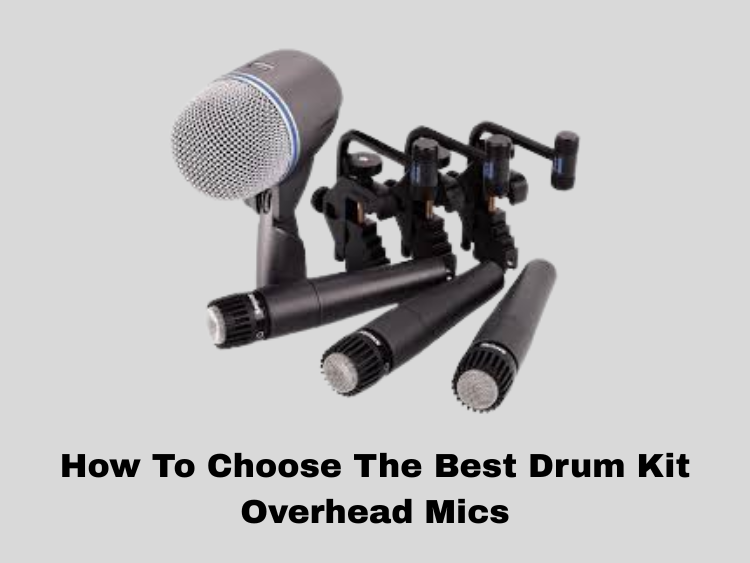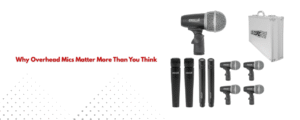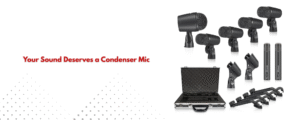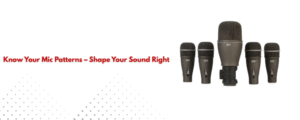If you want your drum kit to sound truly full, you’ll need to capture more than just the kick and snare. Overhead mics are key for capturing that nice stereo image and the crisp sparkle of your cymbals. Whether setting up in a studio or getting ready for a live gig, choosing the right overhead mics can make a big difference. But with so many options, how do you know which ones are right for you? No worries—we’ve got you covered in this article. Here’s what to look for and some solid mic picks to help you.
Know What Overhead Mics Are For
It’s not just drums that overhead mics pick up. They provide a fuller sonic picture of the whole kit—including toms, snare, cymbals, and ambient room sound. Consider them as the glue that holds all the different drum parts together. This is why clarity, stereo image, and frequency response are important.
When It Comes to Microphones, the Condenser Is the Best
Most of the time, condenser mics are used for overheads. They’re known for their sensitivity, fast transient response, and ability to capture fine details and subtleties. This makes them great for recording cymbal movement and a room’s natural echoes.
You should think about two main types of condensers:
- Small Diaphragm Condensers (SDC): People often choose small diaphragm condensers (SDC) for overheads because they have accurate high-frequency responses and great stereo images. They’re great for getting clear drum tones without making the mix less clear.
- Large Diaphragm Condensers (LDC): These can give the sound from above more body and warmth. Some engineers use them when they want a bigger, more atmospheric recording, which can happen in studios with lots of space.
Different Types of Polar Patterns: Cardioid, Omni, and Figure-8
- Cardioid microphones work best in ceiling setups because they pick up sound from the front of the mic but not behind it. This cuts down on bleed from other instruments or shadows in the room.
- In a well-treated room, though, bidirectional mics can be useful if you want to get a sound that is more natural and open. Figure-8 microphones, which are often found in ribbon microphones, can also work well for Blumlein pair or mid-side recording in stereo.
How to Use Stereo: Pick Your Layout
Which sound microphones you buy may depend on the method you choose:
- Spaced Pair (A/B): Two mics are put above the kit but not next to each other. Although this creates a wide stereo picture, it can cause timing problems if it’s not done correctly.
- X/Y Setup: Two cardioid microphones are placed next to each other at a 90° angle. It has a good stereo image and few phase issues, making it great for beginners or mixes that need to be tight.
- ORTF: Combines parts of A/B and X/Y; the mics are 17 cm apart and 110° apart. Gives a more accurate audio picture and good phase synchronization.
If you’re going for any of these methods, make sure the mics you pick are a pair that works well together.
Overhead Mics For Every Budget
Based on different budgets, here are some suggestions:
Beginner ($100 to $300)
- Audio-Technica AT2021: It’s very clear for the price.
- 5Core Drum Mic Kit: A solid budget alternative with decent clarity and build—ideal for basic overhead or instrument miking without breaking the bank.
- Samson C02: These SDCs are easy on the wallet and work well in small workshops.
Mid-Range ($300 to $800)
- Rode NT5: A favorite for both studio and live use.
- sE Electronics sE7: These mics perform well with low self-noise and a clear, balanced tone.
Pro Level ($800 or more)
- Neumann KM184: These are the standards for studio overheads.
- AKG C414 XLII: Low-noise headphones with a variety of polar designs.
Things to Think About in the Room: It’s Not Just the Mics
Your room must sound good. If you put great mics in a room that doesn’t sound good, the overheads will sound sharp and washed out. If the room is too shiny or hasn’t been treated, you might want to use more directional mics to cut down on room bleed, or you could close-mike with a few overheads and use reverb tools to make the area seem bigger.
Ribbon Mics: Something Different
Ribbon mics like the Royer R-121 or the Beyerdynamic M160 can give you a retro or warm, dark sound with a smooth top end that flattens out harsh cymbals. Because they’re figure-8, where you put them and how the room sounds become even more important.
Last Thoughts
Choosing the best drum kit overhead mics can transform your recordings or live sound by capturing the full tone, shimmer, and space of your kit—not just the impact of the kick and snare. From small diaphragm condensers for crisp detail to ribbon mics for vintage warmth, the right gear depends on your room, budget, and musical goals. If you’re starting out or expanding your studio or store inventory, platforms like 5 Core’s business site—a supplier network for audio and electronic gear—can be a useful resource. It offers bulk access to reliable, ready-to-ship equipment for creators, educators, and business partners looking to scale with dependable support and flexible purchase options.





